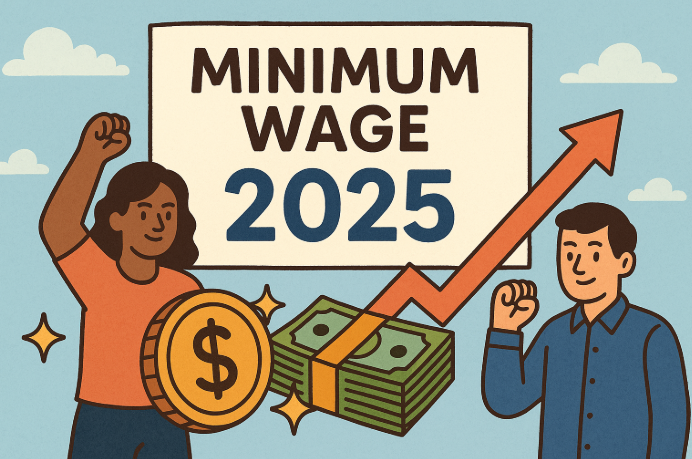Minimum Wage 2025 in the UK matters because it directly impacts workers’ take‑home pay and employer costs. From 1 April 2025, the government raised hourly rates across all age groups. This blog answers key questions, adds a salary calculator, and helps you understand the implications clearly.
What is the National Living Wage for adults in 2025 in the UK?
-
-
The UK increases the National Living Wage (NLW) annually to maintain fair pay.
-
The NLW increased 6.7%, above inflation, to £12.21/hr on April 1, 2025.
-
The Low Pay Commission predicts this will ensure real‑terms pay growth, keeping NLW above two‑thirds of median earnings by March 2026.
-
A full‑time worker (37.5 hrs/week) now earns ~£23,873 per year gross, up from ~£22,368.
-
Around 2.2 million jobs are expected to draw the NLW in 2025, up from 1.9 million in 2024
-
What age does minimum wage start?
The new rates came into effect on 1 April 2025 and apply in all pay periods containing that date.
| Age Group | Rate from 1 April 2025 | Increase |
|---|---|---|
| 18–20 | £10.00/hr | +£1.40 (+16.3%) |
| 16–17 & Apprentices | £7.55/hr | +£1.15 (+18%) |
-
The Low Pay Commission designed these hikes to narrow wage gaps and boost youth coverage .
-
Analysts warn that rising youth employment costs (up to 12.7% real‑terms) may reduce entry‑level job openings.
-
Empirical studies show ~7–10% drop in teenage employment after minimum‑wage rises, especially in competitive markets.
What is the minimum wage for 40 hours a week?
The current 2025 rates correspond to a 40-hour workweek as follows:
| Age Group | Hourly Rate (£/hr) | Weekly (40 hrs) | Annual Gross Equivalent |
|---|---|---|---|
| 21+ (NLW) | 12.21 | £488.40 | ~£25,396 |
| 18–20 | 10.00 | £400.00 | ~£20,800 |
| 16–17 & Apprentices | 7.55 | £302.00 | ~£15,704 |
✅ What this means for you:
-
Workers can estimate take-home pay by applying tax and NI rates to the gross weekly figures.
-
Employers should budget based on these weekly and annual costs and prepare for the probable 2026 increase.
-
Final confirmation of the 2026 rate will happen in October 2025, after the LPC’s recommendation and government review.
How much will a full‑time worker earn at the 2025 NLW rate?

Salary calculator (37.5 hrs/week):
-
£12.21/hr × 37.5 hrs = £458/week
-
£458 × 52 / 12 = £1,988/month
-
Annual gross = £23,808
Estimated deductions (based on gov.uk calculators):
-
Income Tax: ~£2,760/year
-
Employee NI: ~£1,800/year
-
Net take-home:
£19,248/year (£1,604/month)
For deeper insight, use the HMRC or TUC online calculators, including student loans or pension contributions .
For tailored results—including pension or student‑loan deductions—use the gov.uk or TUC calculators.
How do the 2025 Minimum Wage rates compare with the Real Living Wage?
-
-
The voluntary Real Living Wage sits at £12.60/hr UK-wide and £13.85/hr in London.
-
That’s £760+ more/year for full-time workers compared to NLW.
-
In 2024–2025, more than 16,000 firms pledge to implement the Real Living Wage.
-
Evidence shows firms paying a living wage report higher staff retention and morale.
-
How should employers update payroll and check compliance?
Employers must take several compliance steps:
-
Update payroll systems with 2025 rates and accommodation offsets (£10.66/hr)
-
Track worker age/status, especially for apprentices or those turning 21.
-
Include all working time in calculations:
-
Paid training
-
Travel between work assignments or to training
-
On-call hours, meetings, queuing in work time
-
-
Define and record unpaid breaks clearly—otherwise HMRC may treat them as work .
-
Apply accommodation offset correctly;
only deduct up to £10.66/hr if housing provided. -
Use HMRC’s “Check Your Pay” tool to audit and avoid penalties
-
Retain evidence of hours worked, pay rates, and deductions for the past 6 years.
What extra costs do employers face in 2025?

Employers incur multiple additional costs:
-
-
Employer’s National Insurance (NIC) threshold decreased to £5,000 annually and NIC raised from 13.8% to 15%.
-
Example: A full-time NLW employee now incurs £2,879 NIC/year, up 54% from £1,872.
-
Higher youth rates combined with NIC hikes make hiring under‑21s 12–14% more expensive in real terms.
-
SMEs in hospitality and retail report rising operating costs and decreasing staff numbers .
-
Cases show outlets like Pizza Hut franchises shift staff to self-employed to manage costs.
-
How does the UK’s 2025 Minimum Wage compare within the EU?
-
-
At £12.21/hr (~€14), the UK now ranks among the top EU minimum wages .
-
It remains lower than some EU neighbors (e.g., Luxembourg, France) but above many Eastern bloc countries.
-
Why is Minimum Wage 2025 vital for workers and the economy?
Positive effects:
-
Boosts earnings and living standards, especially for low-income households .
-
Reduces low‑pay prevalence from 10% to under 5% since NLW introduction in 2015.
-
Encourages consumer spending, which may reduce inflation and make interest rate reductions possible.
Challenges:
-
-
Rising costs lead some businesses to cut jobs, especially among youth.
-
Young people may face fewer entry-level opportunities, widening the youth unemployment gap (now ~987,000 aged 16–24 NEETs) .
-
Productivity hasn’t risen significantly, and some sectors report more intense workloads post-rises .
-
What will the minimum wage be in 2026?

-
According to the Low Pay Commission, the rate would have to increase to between £12.50 and £12.80/hour starting in April 2026, with a central estimate of £12.65/hour, in order to keep the National Living Wage (NLW) at two-thirds of median wages.
-
These figures serve as indicative targets, contingent on future government remit and real-world wage growth.
-
The Office for Budget Responsibility’s (OBR) March 2024 forecast first predicted £11.75/hr, but in October 2024 it was revised to £12.46/hr for 2026.
-
The final 2026 rate will depend on consultations concluding 30 June 2025, and on the government’s formal remit to the Commission
Conclusion
Minimum Wage 2025 in the UK now stands at:
-
-
-
£12.21/hr for 21+,
-
£10/hr for 18–20,
-
£7.55/hr for under‑18s/apprentices.
-
-
Employers must update payroll, track hours including training/travel, and budget for 15% NIC.
-
Workers benefit from higher earnings, while businesses must adapt to avoid unintended job losses.
-
The Real Living Wage is still optional and higher.
FAQ’s
-
When did the 2025 rates begin?
From 1 April 2025—must apply in any pay period including that date. -
How much does a full-time NLW worker make?
About £1,600/month after tax & NI (~£19,200/year). -
Who qualifies for the apprentice rate?
Under‑19s or apprentices in their first year earn £7.55/hour. -
Can accommodation costs reduce pay?
Yes—up to £10.66/hr offset for employer‑provided accommodation. -
What happens if employers underpay?
HMRC can demand full back‑pay plus penalties and may publicly name non‑compliant employers. -
Why might job cuts occur among young workers?
Rising wage and tax burdens cause some SMEs to reduce staff aged 16–24

I’m Joe Chris, co-author at ukbusinessmag.co.uk and a long-time enthusiast of all things business and finance. My background is in digital marketing and e-commerce, and I love diving into trends that impact the UK business landscape. Through my writing, I aim to make useful, real-world advice accessible to business owners.



